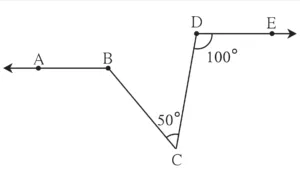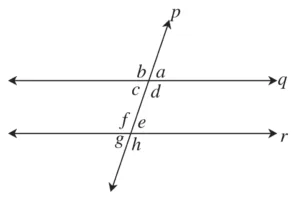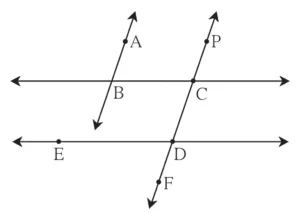Chapter 2 – Parallel Lines
Practice set 2.1
1. In figure 2.5, line RP || line MS and line DK is their transversal. ∠DHP = 85°. Find the measures of following angles.
(i) ∠RHD
(ii) ∠PHG
(iii) ∠HGS
(iv) ∠MGK

Given:
line RP || line MS and line DK is their transversal
∠DHP = 85°
To find:
(i) ∠RHD
(ii) ∠PHG
(iii) ∠HGS
(iv) ∠MGK
Solution:
Line RP || line MS and line DK is their transversal,
(i) ∠DHP + ∠RHD = 180° …[Angles in linear pair]
∴ 85 + ∠RHD = 180
∴ ∠RHD = 180 – 85
∴ ∠RHD = 95°
(ii) ∠PHG ≅ ∠RHD …[Vertically opposite angles]
∵ ∠RHD = 95°
∴ ∠PHG = 95°
(iii) ∠DHP ≅ ∠HGS …[Corresponding angles theorem]
∵ ∠DHP = 85°
∴ ∠HGS = 85°
(iv) ∠HGS ≅ ∠MGK …[Vertically opposite angles]
∵ ∠HGS = 85°
∴ ∠MGK = 85°
Ans: The measures are;
(i) ∠RHD = 95⁰
(ii) ∠PHG = 95⁰
(iii) ∠HGS = 85⁰
(iv) ∠MGK = 85⁰
2. In figure 2.6, line p || line q and line l and line m are transversals. Measures of some angles are shown. Hence find the measures of ∠a, ∠b, ∠c, ∠d.

Given:
Line p || line q and line l and line m are transversals
Measures of two angles are 100⁰ and 115⁰.
To find:
∠a
∠b
∠c
∠d
Solution:
∠a + 110 = 180 …[Angles in linear pair]
∴ ∠a = 180 – 110
∴ ∠a = 70°
Line p || line q and line l is their transversal
∠b ≅ ∠a …[Exterior Alternate angles theorem]
∵ ∠a = 70⁰
∴ ∠b = 70⁰
Line p || line q and line l is their transversal
∠c = 115° …[Corresponding angles theorem]
∠d + 115 = 180 …[Angles in linear pair]
∴ ∠d = 180 – 115
∴ ∠d = 65°
Ans: The measures are;
∠a = 70⁰
∠b = 70⁰
∠c = 115⁰
∠d = 65⁰
3. In figure 2.7, line l || line m and line n || line p. Find ∠a, ∠b, ∠c from the given measure of an angle.

Given:
line l || line m
line n || line p
One angle is 45⁰
To find:
∠a
∠b
∠c
Solution:
Let us mark an angle ‘d’ as shown in the figure,
∴ ∠d = 45° …[Vertically opposite angles]
Line p || line q and line l is their transversal,
∠d + ∠a = 180° …[Interior angles theorem]
∴ 45 + ∠a = 180
∴ ∠a = 180 – 45
∴ ∠a = 135°
∴ ∠b = ∠a …[Vertically opposite angles]
∵ ∠a = 135°
∴ ∠b = 135°
Line n || line p and line m is their transversal,
∠c ≅ ∠b …[Corresponding angles theorem]
∵ ∠b = 135°
∴ ∠c = 135°
Ans: The measures are;
∠a = 135⁰
∠b = 135⁰
∠c = 135⁰
4*. In figure 2.8, sides of ∠PQR and ∠XYZ are parallel to each other. Prove that, ∠PQR ≅ ∠XYZ

Given:
Line PQ || line XY
Line QR || line YZ
To prove:
∠PQR ≅ ∠XYZ
Construction:
Extend ray XY to intersect ray QR at point M, such that Q – M – R

Solution:
Line PQ || line XM and QR is their transversal …[Given, X – Y – M]
∠PQR ≅ ∠XMR …(i) [Corresponding angles theorem]
Line YZ || line QR and XM is their transversal …[Given]
∠XYZ ≅ ∠XMR …(ii) [Corresponding angles theorem]
∴ ∠PQR ≅ ∠XYZ …[From (i) and (ii)]
Hence proved.
5. In figure 2.9, line AB || line CD and line PQ are transversal. Measure of one of the angles is given. Hence find the measures of the following angles.
(i) ∠ART
(ii) ∠CTQ
(iii) ∠DTQ
(iv) ∠PRB

Given:
Line AB || line CD and line PQ are transversal.
∠BRT = 105⁰
To find:
(i) ∠ART
(ii) ∠CTQ
(iii) ∠DTQ
(iv) ∠PRB
Solution:
(i) ∠BRT + ∠ART = 180° …[Angles in linear pair]
∴ 105 + ∠ART = 180
∴ ∠ART = 180 – 105
∴ ∠ART = 75°
(ii) Line AB || line CD and line PQ are transversal.
∠ART ≅ ∠CTQ …[Corresponding angles theorem]
∵ ∠ART = 75°
∴ ∠CTQ = 75°
(iii) Line AB || line CD and line PQ are transversal
∠BRT ≅ ∠DTQ …[Corresponding angles theorem]
∵ ∠BRT = 105⁰
∴ ∠DTQ = 105°
(iv) ∠PRB ≅ ∠ART …[Vertically opposite angles]
∵ ∠ART = 75°
∴ ∠PRB = 75°
Ans: The measures are;
(i) ∠ART = 75⁰
(ii) ∠CTQ = 75⁰
(iii) ∠DTQ = 105⁰
(iv) ∠PRB = 75⁰
Practice set 2.2
1. In figure 2.18, y = 108° and x = 71° Are the lines m and n parallel? Justify?

Given:
y = 108°
x = 71°
To find:
Whether the lines m and n are parallel
Solution:
∠y = 108° …(i)
∠x = 71° …(ii)
Here, ∠x and ∠y form a pair of interior angles.
Hence their sum should be 180⁰
Adding (i) and (ii), we get,
∠x + ∠y = 71 + 108
∴ ∠x + ∠y = 179° ≠ 180⁰
Since, ∠x and ∠y are not supplementary,
∴ line m is not parallel to line n.
Ans: Line m is not parallel to line n.
2. In figure 2.19, if ∠a ≅ ∠b then prove that line l || line m.

Given:
∠a ≅ ∠b
To prove:
line l || line m
Proof:
∠a ≅ ∠c …(i) [Vertically opposite angles]
∠a ≅ ∠b …(ii) [Given]
∴ ∠b ≅ ∠c …[From (i) and (ii)]
∴ line l line m …[Corresponding angles test]
Hence proved.
3. In figure 2.20, if ∠a ≅ ∠b and ∠x ≅ ∠y then prove that line l || line n.

Given:
∠a ≅ ∠b
∠x ≅ ∠y
To prove:
line l || line n
Proof:
∠a ≅ ∠b …[Given]
∴ line l || line m … (i) [Corresponding angles test]
∠x ≅ ∠y …[Given]
∴ line n || line m …(ii) [Alternate angles test]
∴ line l || line n …[From (i) and (ii)]
Hence proved.
4. In figure 2.21, if ray BA || ray DE, ∠C = 50° and ∠D = 100°. Find the measure of ∠ABC.
(Hint : Draw a line passing through point C and parallel to line AB.)

Given:
ray BA || ray DE
∠C = 50°
∠D = 100°
To find:
∠ABC
Construction:
Draw a line passing through point C and parallel to line AB.

Solution:
line AB || line CF. …(i) [Construction]
line AB || line DE. …(ii) [Given]
∴ line DE || line CF …[From (i) and (ii)]
line DE || line CF and DC is their transversal,
∠EDC + ∠DCF = 180° …[Interior angles theorem]
∴ 100 + ∠DCF = 180
∴ ∠DCF = 180 – 100
∴ ∠DCF = 80°
∠BCF = ∠BCD + ∠DCF …[Angle addition property]
∴ ∠BCF = 50 + 80
∴ ∠BCF = 130°
line AB || line CF and BC is their transversal,
∠ABC ≅ ∠BCF …[Alternate angles theorem]
∵ ∠BCF = 130°
∴ ∠ABC = 130°
Ans: The measure of ∠ABC is 130°.
5. In figure 2.22, ray AE || ray BD, ray AF is the bisector of ∠EAB and ray BC is the bisector of ∠ABD. Prove that line AF || line BC.

Given:
ray AE || ray BD
ray AF is the bisector of ∠EAB
ray BC is the bisector of ∠ABD
To prove:
line AF || line BC
Proof:
∠EAF ≅ ∠BAF = x …(i) [∵ ray AF bisects ∠EAB]
∠DBC = ∠ABC = y …(ii) [∵ ray BC bisects ∠ABD]
ray AE || ray BD and AB is the transversal …[Given]
∠EAB ≅ ∠ABD …[Alternate angles theorem]
∴ ∠EAF + ∠BAF = ∠ABC + ∠DBC …[Angles addition property]
x + x = y + y …[From (i) and (ii)]
∴ 2x = 2y
∴ x = y
∴ ∠FAB ≅ ∠ABC
∴ line AF line BC …[Alternate angles test]
Hence proved.
6. A transversal EF of line AB and line CD intersects the lines at point P and Q respectively. Ray PR and ray QS are parallel and bisectors of ∠BPQ and ∠PQC respectively. Prove that line AB || line CD.

Given:
Ray PR || ray QS bisectors of
Ray PR bisect ∠BPQ
Ray PR bisect ∠PQC
To prove:
line AB || line CD
Proof:
Let,
∠BPR ≅ ∠QPR = x …(i) [∵ ray PR bisects ∠BPQ]
∠CQS ≅ ∠PQS = y …(ii) [∵ ray QS bisects ∠PQC]
∴ ∠BPQ = ∠BPR + ∠QPR …[Angles addition property]
∴ ∠BPQ = x + x …[From (i)]
∴ ∠BPQ = 2x …(iii)
Similarly, we will get
∴ ∠PQC = 2y …(iv)
Ray PR || ray QS and PQ is the transversal …[Given]
∠QPR ≅ ∠PQS …[Alternate angles theorem]
∴ x = y …[From (i) and (ii)]
∴ 2(x) = 2(y) …[Multiplying by 2 on both sides]
∴ ∠BPQ = ∠PQC …[From (iii) and (iv)]
∴ line AB line CD …[Alternate angles test]
Hence proved.
Problem Set 2
1. Select the correct alternative and fill in the blanks in the following statements.
(i) If a transversal intersects two parallel lines then the sum of interior angles on the same side of the transversal is ______
(A) 0°
(B) 90°
(C) 180°
(D) 360°
Ans: Option (C) : 180°

Solution:
line l || line m and n is the transversal,
∠a + ∠b = 180° …[Interior angles theorem]
(ii) The number of angles formed by a transversal of two lines is ______
(A) 2
(B) 4
(C) 8
(D) 16
Ans: Option (C) : 8

Solution:
lines l || line m and line n is the transversal.
The number of angles formed by a transversal of two lines as shown in the figure is 8.
(iii) A transversal intersects two parallel lines. If the measure of one of the angles is 40°then the measure of its corresponding angle is ______
(A) 40°
(B) 140°
(C) 50°
(D) 180°
Ans: Option (A) : 40°

Solution:
line l || line m and n is the transversal,
∠a ≅ ∠b …[Corresponding angles theorem]
∵ ∠a = 40°
∴ ∠b = 40°
(iv) In ∆ABC, ∠A = 76°, ∠B = 48°, ∠C = ______
(A) 66°
(B) 56°
(C) 124°
(D) 28°
Ans: Option (B) : 56°

Solution:
In ∆ABC,
∠A + ∠B + ∠C = 180° …[Sum of measures of all angles of a triangle is 180°]
∴ 76 + 48 + ∠C = 180
∴ 124 + ∠C = 180
∴ ∠C = 180 – 124
∴ ∠C = 56°
(v) Two parallel lines are intersected by a transversal. If measure of one of the alternate interior angles is 75° then the measure of the other angle is ______
(A) 105°
(B) 15°
(C) 75°
(D) 45°
Ans: Option (C) : 75°

Solution:
line l || line m and n is the transversal
∠a ≅ ∠b …[Alternate angles theorem]
∵ ∠a = 75°
∴ ∠b = 75°
2*. Ray PQ and ray PR are perpendicular to each other. Points B and A are in the interior and exterior of ∠QPR respectively. Ray PB and ray PA are perpendicular to each other.

(i) A pair of complementary angles
Ans:
(a) ∠QPB and ∠BPR
(b) ∠BPR and ∠RPA
(ii) A pair of supplementary angles.
Ans: ∠QPR and ∠BPA
(iii) A pair of congruent angles.
Ans:
(a) ∠QPR and ∠BPA
(b) ∠QPB and ∠RPA
3. Prove that, if a line is perpendicular to one of the two parallel lines, then it is perpendicular to the other line also.

Given:
Line AB || line CD and line EF intersects them at points M and N respectively.
line EF ⊥ line AB
To prove:
line EF ⊥ line CD
Proof:
line AB line CD and EF is the transversal
∠EMB ≅ ∠MND …(i) [Corresponding angles theorem]
∵ ∠EMB = 90° …(ii) [Given]
∴ ∠MND = 90° …[From (i) and (ii)]
∴ line EF ⊥ line CD
Hence proved.
4. In figure 2.24, measures of some angles are shown. Using the measures find the measures of ∠x and ∠y and hence show that line l || line m.

Given:
∠AME = 130⁰
∠MND = 150⁰
To find:
∠x and ∠y
To prove:
line l || line m
Solution:
∠BMN ≅ ∠AME …[Vertically opposite angles]
∴ ∠x = 130°
∠CNF = ∠MND …[Vertically opposite angles]
∴ ∠y = 50°
∠BMN + ∠MND = 130 + 50
∴ ∠BMN + ∠MND = 180°
But,
∠BMN and ∠MND are interior angles
∴ line l || line m …[By Interior angles test]
Hence proved.
Ans: The measures of ∠x is 130⁰ and ∠y = 50⁰
5. Line AB || line CD || line EF and line QP is their transversal. If y : z = 3 : 7 then find the measure of ∠x. (See figure 2.25.)

Given:
Line AB || line CD || line EF and line QP is their transversal
y : z = 3 : 7
To find:
∠x
Solution:
∠y = ∠z = 3 : 7 …[Given]
Let the common multiple be a
∴ ∠y = 3a and ∠z = 7a
line AB || line EF and PQ is the transversal,
∴ ∠x ≅ ∠z …[Alternate angles theorem]
∵ ∠z = 7a
∴ ∠x = 7a
line AB || line CD and PQ is the transversal,
∠x + ∠y = 180° …[Interior angles theorem]
∴ 7a + 3a = 180
∴ 10a = 180
∴ a = \(\large \frac {180}{10}\)
∴ a = 18
Now,
∠x = 7a
∴ ∠x = 7 × 18
∴ ∠x = 126⁰
Ans: The measure of ∠x is 126⁰.
6. In figure 2.26, if line q || line r, line p is their transversal and if a = 80° find the values of f and g.

Given:
line q || line r, line p is their transversal
∠a = 80°
To find:
∠f and ∠g
Solution:
∠a + ∠b = 180° …[Angles in linear pair]
∴ 80 + ∠b = 180
∴ ∠b = 100°
∠c = ∠a …[Vertically opposite angles
∵ ∠a = 80°…[Given]
∴ ∠c = 80°
line q || line r and line p is their transversal
∠f = ∠b …[Corresponding angles theorem]
∵ ∠b = 100°
∴ ∠f = 100°
∠g = ∠c …[Corresponding angles theorem]
∵ ∠a = 80⁰
∴ ∠g = 80°
Ans: The measures of ∠f is 100° and ∠g is 80°.
7. In figure 2.27, if line AB || line CF and line BC || line ED then prove that ∠ABC = ∠FDE.

Given:
line AB || line CF
line BC || line ED
To prove:
∠ABC ≅ ∠FDE
Proof:
line AB || line CF and BC is the transversal,
∠ABC = ∠BCD …(i) [Alternate angles theorem]
line BC || line ED and BC is the transversal,
∠FDE = ∠BCD …(ii) [Corresponding angles theorem]
∴ ∠ABC = ∠FDE …[From (i) and (ii)]
Hence proved.
8. In figure 2.28, line PS is a transversal of parallel line AB and line CD. If Ray QX, ray QY, ray RX, ray RY are angle bisectors, then prove that □ QXRY is a rectangle.

Given:
Line AB || line CD and PS is the transversal
Ray QX, ray QY, ray RX, ray RY are angle bisectors
To prove:
□ QXRY is a rectangle
Solution:
Let, ∠AQX = ∠RQX = a …(i)
∠BQY = ∠RQY = b …(ii)
∠CRX = ∠QRX = c …(iii)
∠DRY = ∠QRY = d …(iv) [∵ Rays QX, QY, RX, RY are the bisectors of ∠AQR, ∠BQR, ∠QRC, ∠QRD respectively]
∠AQR + ∠BQR = 180° …[Angles in linear pair]
∴ 2a + 2b = 180
∴ a + b = 90
∴ ∠RQX + ∠RQY = 90° …[From (i) and (ii)]
∴ ∠XQY = 90° …(v) [Angles addition property]
Similarly, we can prove,
c + d = 90⁰
∴ ∠QRX + ∠QRY = 90⁰
∴ ∠XRY = 90° …(vi)
line AB || line CD and PS is the transversal,
∠AQR + ∠CRQ = 180° …[Interior angles theorem]
∴ 2a + 2c = 180
∴ ∠a + ∠c = 90 …(vii)
In ∆XQR,
∠QXR + ∠XQR + ∠XRQ = 180° …[Sum of measures of all angles of a triangle is 180⁰]
∴ ∠QXR + ∠a + ∠c = 180 …[From (i) and (iii)]
∴ ∠QXR + 90 = 180 …[From (vii)]
∴ ∠QXR = 90° …(viii)
Similarly, we can prove
∠QYR = 90° …(ix)
In □ QXRY,
∴ ∠XQY ≅ ∠QXR ≅ ∠XRY ≅ ∠RYQ = 90° …[From (v), (vi), (viii) and (ix)]
∴ QXRY is a rectangle …[By definition]
Hence proved.
